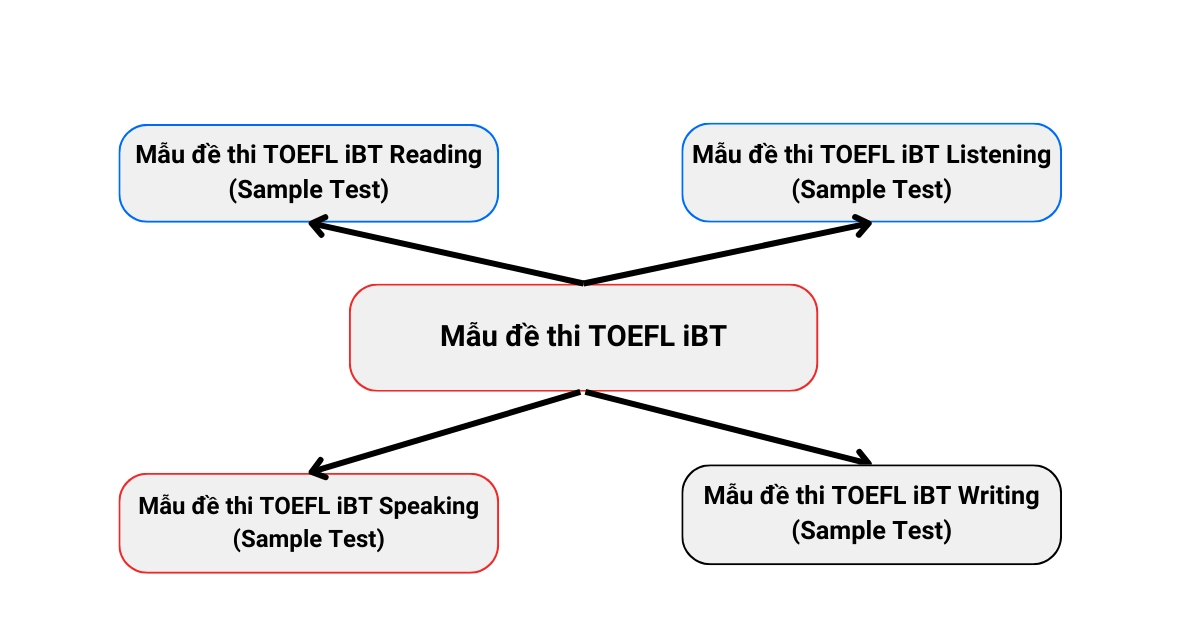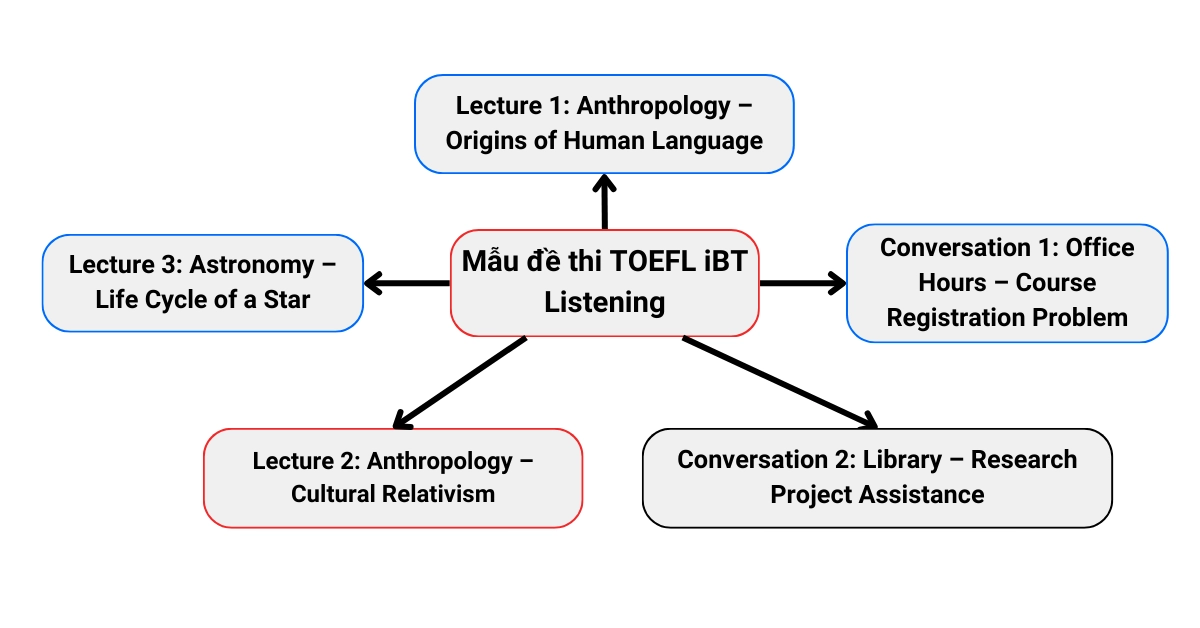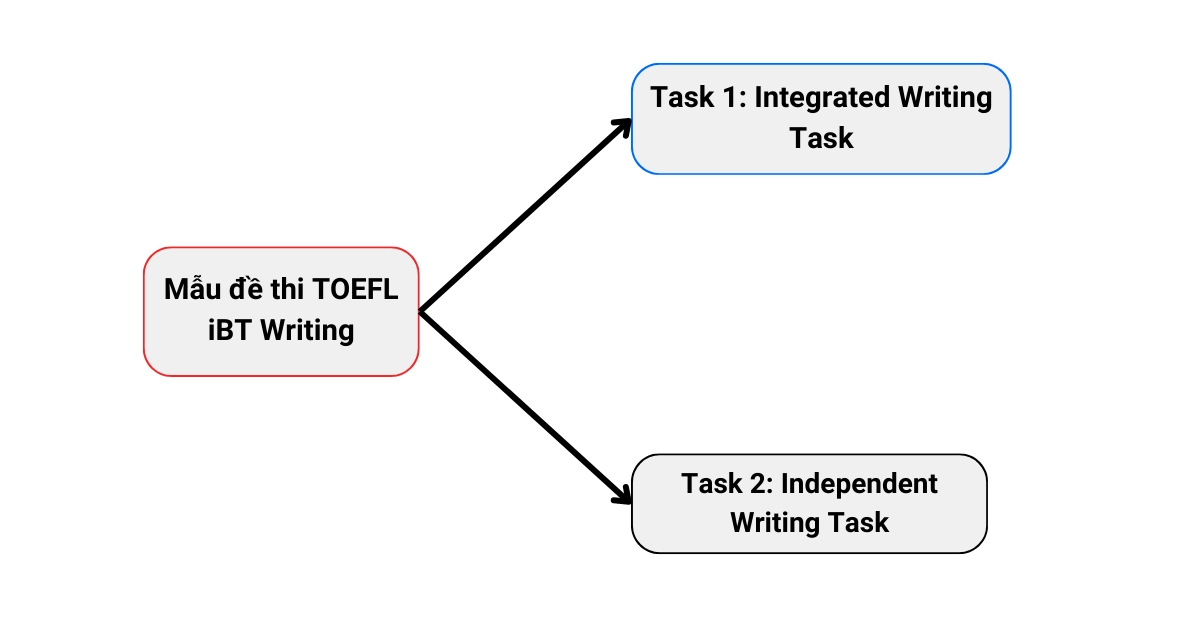Mẫu đề thi TOEFL iBT® tham khảo (Có đáp án chi tiết)
Key takeaways
Reading: Đọc hiểu, xác định ý chính, so sánh thông tin.
Listening: Hiểu chi tiết, phân tích mục đích, lập luận.
Speaking: Trả lời mạch lạc, phát triển ý, ví dụ phù hợp.
Writing: Viết luận độc lập và tích hợp, lập luận rõ ràng, ví dụ minh họa.
Trong quá trình chuẩn bị cho kỳ thi TOEFL iBT, việc luyện tập với các đề thi mẫu đóng vai trò vô cùng thiết yếu. Những bài thi mẫu không chỉ giúp thí sinh làm quen với cấu trúc đề thi thật mà còn hỗ trợ rèn luyện kỹ năng quản lý thời gian và nâng cao khả năng phản xạ ngôn ngữ trong môi trường thi cử thực tế. Bên cạnh đó, việc thường xuyên luyện đề còn giúp người học phát hiện ra điểm mạnh và điểm yếu của bản thân, từ đó xây dựng chiến lược ôn tập hiệu quả hơn. Chính vì vậy, sử dụng các mẫu đề thi TOEFL iBT là một trong các bước chuẩn bị không thể thiếu để đạt được kết quả cao trong kỳ thi này.

Mẫu đề thi TOEFL iBT Reading (Sample Test)
Passage 1
The Domestication of Animals
The domestication of animals marked a major turning point in the development of human societies. This shift enabled early humans to transition from roaming hunter-gatherers to inhabitants of stable, agriculture-based communities. Starting over 10,000 years ago in various regions, the domestication process unfolded gradually and required deliberate human involvement. It involved not only taming but also selective breeding across generations, leading to genetic changes that made certain species more useful to humans. Importantly, while many animals have been trained or managed, only a select few have undergone true domestication—defined by humans controlling reproduction to encourage advantageous traits.
Among the first animals to be domesticated was the dog, believed to have descended from wolves that began frequenting human campsites. Uniquely, it is suggested that dogs played an active role in their own domestication by seeking out the benefits of living near people. Those wolves that were less aggressive and more tolerant of humans were more likely to survive and reproduce, gradually evolving into animals with tameness, altered coat colors, and features associated with juvenile wolves—such as floppy ears or shorter snouts.
Larger livestock species—such as sheep, goats, and cattle—were domesticated later and had an even greater influence on human life. These animals offered steady supplies of food, clothing materials, and even labor for farming. Yet, very few animals possess the full set of traits required for successful domestication. According to geographer Jared Diamond, the ideal candidates must have a non-specialized diet, mature quickly, reproduce well in captivity, have a calm temperament, live in herds with clear social hierarchies, and show limited panic responses. These stringent requirements explain why only a handful of animals have ever been truly domesticated.
A comparison between zebras and horses highlights this point. Despite their similar physical build, zebras have never been domesticated due to their erratic behavior, heightened fear responses, and resistance to accepting humans as leaders. Horses, on the other hand, were successfully domesticated around 5,500 years ago. Their natural social structure and willingness to follow a dominant figure made them ideal for tasks such as transportation, farming, and warfare.
Beyond behavior, domestication has also brought about significant biological changes in animals. Domesticated species often look and behave very differently from their wild ancestors, exhibiting a phenomenon known as the "domestication syndrome." This includes traits like drooping ears, shorter jaws, smaller brains, and altered reproductive patterns. Scientists now believe these features may be linked to subtle changes in neural crest cells during embryonic development—offering a fascinating insight into how domestication reshapes animals at a genetic and developmental level.
In conclusion, animal domestication was not a simple or accidental process. It involved a deep interaction between human cultural needs, environmental conditions, and animal biology. The species that adapted to this relationship not only contributed profoundly to human progress but were also fundamentally changed in the process.
Questions:
What is the main purpose of the passage?
(A) To explain the economic benefits of domesticating animals
(B) To describe the process and impact of animal domestication
(C) To compare ancient human societies
(D) To discuss wildlife and conservationAccording to the passage, what differentiates domesticated animals from tamed animals?
(A) Domesticated animals are more obedient than tamed animals
(B) Tamed animals live in the wild while domesticated ones live on farms
(C) Domesticated animals have undergone genetic changes controlled by humans
(D) Tamed animals are used for work while domesticated animals are used for foodWhy does the author mention dogs in paragraph 2?
(A) To show how dogs have become more intelligent than wolves
(B) To provide an example of an animal that was domesticated through its own behavior
(C) To illustrate that dogs were bred for hunting and protection
(D) To contrast dogs with other failed domestication attemptsWhich of the following is NOT listed as one of Diamond's criteria for successful domestication?
(A) Ability to digest multiple types of food
(B) Calm behavior in the wild
(C) Ability to breed in captivity
(D) Strong social hierarchyWhat can be inferred about zebras based on the passage?
(A) They are genetically identical to horses
(B) They were once domesticated but became wild again
(C) Their behavior makes them unsuitable for domestication
(D) They live in areas where humans rarely attempted domesticationThe word “docile” in paragraph 3 is closest in meaning to:
(A) intelligent
(B) submissive
(C) wild
(D) physically strongAccording to the passage, why was the horse more suitable for domestication than the zebra?
(A) It was less aggressive and more social
(B) It ran slower and was easier to catch
(C) It produced more milk and meat
(D) It lived closer to early human settlementsWhat is the "domestication syndrome"?
(A) A behavioral disease found in all domestic animals
(B) A scientific term for changes in animal diet due to domestication
(C) A set of physical and behavioral traits seen in domesticated animals
(D) The process by which humans genetically alter wild animalsWhich of the following best describes the organization of the passage?
(A) A historical overview followed by a list of examples
(B) A comparison of wild and domestic animals across regions
(C) A description of domestication followed by an analysis of its biological effects
(D) A narrative of how humans learned to tame animalsWhat is the significance of the discovery about neural crest cells mentioned in the final paragraph?
(A) It proves that all animals can be domesticated
(B) It explains the genetic basis for common traits in domesticated animals
(C) It reveals why only dogs and horses have been successfully domesticated
(D) It shows how animals choose to be domesticated through natural instinct

Passage 2
The Rise and Decline of the Indus Valley Civilization
Among the earliest known urban cultures in human history, the Indus Valley Civilization (IVC)—also called the Harappan Civilization—flourished from around 2600 to 1900 BCE in areas that are now part of Pakistan and northwestern India. At its height, this civilization extended across more than a million square kilometers, encompassing key cities such as Harappa, Mohenjo-Daro, and Dholavira. These urban centers were distinguished by their sophisticated infrastructure, including grid-based street layouts, advanced drainage systems, uniform building materials, and evidence of widespread trade. Despite these accomplishments, the civilization continues to puzzle scholars due to its undeciphered script and the unclear reasons behind its decline.
One of the most impressive aspects of the Indus Valley cities was their methodical urban planning. Unlike the irregular and haphazard designs of many other ancient cities, Indus settlements were carefully organized with streets aligned along cardinal directions and divided into well-defined blocks. Homes were constructed using standardized, kiln-fired bricks, and many included private wells and toilets, with wastewater channeled into covered street drains—a level of civic engineering far ahead of its time.
Trade was central to the Harappan economy. Excavations have uncovered goods such as beads, ceramics, and cotton fabrics that indicate commercial exchange with distant regions like Mesopotamia. Indus seals, often bearing inscriptions in the still-unreadable script, have been found as far away as the Persian Gulf, suggesting their use in trade or administrative activities. The presence of standardized weights and measures points to a shared economic framework, although the absence of royal structures such as palaces or tombs makes it difficult to determine the political organization of the society.
The causes of the civilization’s decline around 1900 BCE remain the subject of ongoing research. Environmental factors are widely considered to have played a major role. One theory suggests that the Ghaggar-Hakra River—thought by some to be the fabled Sarasvati—gradually dried up, disrupting agriculture and trade networks. Recent geological studies and satellite imagery support this idea, revealing a trend toward increasing aridity during the late Harappan period.
Other scholars argue that internal issues, such as resource overuse, weakening trade connections, or societal fragmentation, may have led to a gradual erosion of urban life. Rather than a sudden collapse, evidence suggests a slow decline, with populations abandoning large cities in favor of smaller rural settlements. While some cultural traditions continued in these later communities, the sophisticated urbanism of the IVC was not maintained.
Today, the legacy of the Indus Valley Civilization is still visible in South Asia’s cultural and technological foundations. Its achievements in town planning, craftsmanship, and agricultural methods influenced future societies in the region. Yet much about the civilization remains elusive. Without a clear understanding of the Indus script, scholars can only speculate about its political systems, religious beliefs, and daily life. Until new discoveries are made, the Harappans will remain one of the most fascinating and mysterious civilizations of the ancient world.
Questions:
What is the main idea of the passage?
(A) The Indus Valley Civilization was the first civilization to create writing.
(B) The IVC was a highly advanced urban society whose legacy remains, though much of it is still not fully understood.
(C) The IVC collapsed due to war and natural disasters.
(D) Modern cities copied their layout from the IVC.Which of the following best describes the urban design of Indus cities?
(A) Circular streets surrounding a central palace
(B) Unplanned layouts formed over time
(C) Grid-like patterns with advanced drainage systems
(D) Temporary settlements with no permanent structureWhy is the Indus script important to historians?
(A) It proves the Harappans spoke the same language as Mesopotamians
(B) It reveals their trade secrets
(C) It could offer insights into their political, religious, and social systems
(D) It helps confirm the dates of their military campaignsWhat does the author imply about the political system of the Indus Valley?
(A) It was ruled by a powerful king in a central palace
(B) It was likely decentralized due to the absence of royal monuments
(C) It followed the same model as Mesopotamia
(D) It was theocratic, with temples at the center of every cityThe word "sophisticated" in paragraph 1 is closest in meaning to:
(A) elaborate
(B) ancient
(C) unknown
(D) unfinishedWhat evidence suggests that the Indus Valley engaged in international trade?
(A) Military artifacts from Egypt
(B) Palaces filled with imported goods
(C) Indus seals found in distant regions such as the Persian Gulf
(D) Coins showing foreign leaders’ imagesWhat is one theory for the decline of the IVC supported by satellite and sediment analysis?
(A) Disease outbreaks
(B) Invasion by nomadic tribes
(C) Drying up of the Ghaggar-Hakra River
(D) Overpopulation and warHow does the author describe the nature of the IVC’s decline?
(A) Sudden and violent collapse caused by external attack
(B) Gradual process of urban decline and migration
(C) Complete destruction of all cities in a short period
(D) Recovery followed by re-urbanization in the same regionsWhich of the following is NOT mentioned as a possible cause of the Indus Valley’s decline?
(A) Invasion by foreign powers
(B) Climate change
(C) Shifting river systems
(D) Resource depletionWhat is the tone of the passage regarding the IVC's historical legacy?
(A) Dismissive and critical
(B) Neutral and disinterested
(C) Respectful and curious
(D) Skeptical and doubtful
Mẫu đề thi TOEFL iBT Listening (Sample Test)

Lecture 1: Anthropology – Origins of Human Language
Context: A professor is giving a lecture in an introductory anthropology class.
Questions:
What is the main topic of the lecture?
(A) The history of anthropology
(B) The evolution of early primates’ language
(C) The origin and development of human’s ways of communication
(D) The study of ancient civilizationsAccording to the professor, what does the FOXP2 gene help scientists understand?
(A) The origins of ancient texts
(B) How primates build communities
(C) The biological basis of language in humans
(D) How children learn languagesWhat does the professor say about gestures?
(A) They are used only in modern languages
(B) They are a possible starting point for language evolution
(C) They replaced vocal communication in early humans
(D) They are not relevant to language studiesWhy does the professor mention the 'musical protolanguage' theory?
(A) To dismiss it as outdated
(B) To compare it with the FOXP2 gene theory
(C) To provide an alternative explanation of language origins
(D) To explain how music evolved from languageWhat is implied about the study of language development?
(A) It can be explained entirely by genetics
(B) It requires a combination of disciplines
(C) It is no longer studied by anthropologists
(D) It focuses mainly on modern languagesWhat can be inferred about language change over time?
(A) It always improves with each generation
(B) It is primarily influenced by genetic changes
(C) It occurs due to cultural use and interaction
(D) It stops once a language is written down
Conversation 1: Office Hours – Course Registration Problem
Context: A student is speaking with an academic advisor about a problem with course registration.
Questions:
What problem is the student experiencing?
(A) A missing prerequisite
(B) A scheduling conflict
(C) An inability to register for a required class
(D) A lost library bookWhy couldn’t the student register for the course earlier?
(A) They missed the deadline
(B) The course was cancelled
(C) They had a hold on their account
(D) Their advisor didn’t approve the courseWhat does the advisor suggest the student do first?
(A) Wait until next semester
(B) File a complaint with the department
(C) Take a different general education course
(D) Email the course professorWhat is one alternative course the advisor mentions?
(A) Environmental Chemistry
(B) Human Biology
(C) Ecology and Human Impact
(D) Introduction to Earth ScienceWhat can be inferred about the advisor’s attitude?
(A) Impatient but helpful
(B) Supportive and practical
(C) Indifferent and passive
(D) Strict but fair
Conversation 2: Library – Research Project Assistance
Context: A student is talking with a university librarian about finding sources for a research paper.
Questions
What is the student’s main problem?
(A) She doesn’t understand the topic of her paper
(B) She can’t find enough reliable sources
(C) She missed the library workshop
(D) She needs help formatting her paperWhat does the librarian suggest the student do first?
(A) Visit the history department
(B) Use Google Scholar
(C) Search the library’s online databases
(D) Check books in the library stacksWhat feature of the database helps the student find peer-reviewed articles?
(A) A subject category filter
(B) A “Scholarly Journals” checkbox
(C) A search history option
(D) A sorting tool by dateWhat citation style is the student required to use?
(A) MLA
(B) Chicago
(C) Harvard
(D) APAWhat service does the librarian mention if an article isn’t fully available?
(A) Full-text subscription
(B) Citation generator
(C) Faculty login
(D) Interlibrary loan
Lecture 2: Anthropology – Cultural Relativism

Context: A professor is introducing the concept of cultural relativism in an introductory anthropology class.
Questions
What is the main topic of the lecture?
(A) How early anthropologists collected data
(B) The role of human rights in anthropology
(C) The concept of cultural relativism
(D) The nutritional value of insectsWhat problem did cultural relativism aim to solve?
(A) The spread of disease in developing countries
(B) Lack of universal moral values
(C) Misunderstanding caused by ethnocentrism
(D) The decline of traditional healing practicesAccording to the professor, what is a common misconception about cultural relativism?
(A) That it promotes the superiority of one culture
(B) That it requires full moral approval of all practices
(C) That it was invented in the 21st century
(D) That it only applies to food-related customsWhy does the professor mention eating insects?
(A) To criticize Western eating habits
(B) To illustrate a practice misunderstood without cultural relativism
(C) To explain a common anthropological method
(D) To show how cultures reject certain beliefsHow is cultural relativism used in medical anthropology?
(A) To compare ancient and modern medicine
(B) To encourage hospitals to use traditional remedies
(C) To understand indigenous healing within its cultural framework
(D) To evaluate treatments based on scientific evidenceWhat is one criticism of cultural relativism mentioned in the lecture?
(A) It rejects the use of science
(B) It fails to promote empathy
(C) It can be used to justify harmful actions
(D) It limits cross-cultural communication
Lecture 3: Astronomy – Life Cycle of a Star
Context: A professor is giving a lecture in an introductory astronomy course.
Questions
What is the lecture mainly about?
(A) The formation of galaxies
(B) The birth and death of stars
(C) The chemical makeup of the universe
(D) The structure of the solar systemAccording to the professor, what triggers the birth of a star?
(A) A planetary explosion
(B) A sudden drop in temperature
(C) The collapse of gas and dust in a nebula
(D) The expansion of a white dwarfWhat happens during the main sequence phase of a star’s life?
(A) It grows larger and cooler
(B) It fuses hydrogen into helium
(C) It begins collapsing inward
(D) It explodes into a supernovaWhat is the final stage of a low to medium mass star?
(A) Neutron star
(B) Black hole
(C) Red giant
(D) White dwarfWhich stellar event leads to the formation of a black hole?
(A) The cooling of a white dwarf
(B) The explosion of a low-mass star
(C) The collapse of a very massive star’s core
(D) The fusion of helium into hydrogenWhat determines the overall life path of a star?
(A) Its distance from the sun
(B) Its speed of rotation
(C) Its mass
(D) Its age
Mẫu đề thi TOEFL iBT Speaking (Sample Test)

Task 1: Independent Speaking
Question:
Describe a memorable experience you had while learning something new. Explain why it was memorable. Include specific details in your response.
Time to prepare: 15 seconds
Time to speak: 45 seconds
Task 2: Integrated Speaking
Reading passage (45 seconds to read)
Title: Groupthink
Groupthink is a psychological phenomenon that occurs within a group of people when the desire for harmony or conformity results in an irrational or dysfunctional decision-making outcome. Members suppress dissenting opinions, fail to critically analyze alternatives, and prioritize consensus over accuracy.
Listening passage (Professor’s lecture)
Question:
Explain how the example from the professor’s lecture illustrates the concept of groupthink.
Preparation time: 30 seconds
Speaking time: 60 seconds
Task 3: Integrated Speaking
Reading (45 seconds):
University to Reduce On-Campus Parking
The university administration has announced that it will reduce the number of parking spaces on campus. The decision is part of a plan to make the campus more environmentally friendly. According to the administration, fewer parking spaces will encourage students and faculty to use public transportation or bicycles instead of driving. The plan also includes creating more green spaces where parking lots used to be.
Listening (Conversation between two students):
Question:
The man expresses his opinion about the university’s new plan. State his opinion and explain the reasons he gives for holding that opinion.
Preparation time: 30 seconds
Response time: 60 seconds
Task 4: Integrated Speaking
Listening passage (Professor’s lecture)
Question:
Using points and examples from the lecture, explain how animals use environmental cues during migration.
Preparation time: 20 seconds
Speaking time: 60 seconds
Mẫu đề thi TOEFL iBT Writing (Sample Test)

Task 1: Integrated Writing Task
Reading Passage:
Topic: Decline of Bees
In recent decades, there has been a significant decline in bee populations worldwide. Scientists have proposed several possible explanations. First, the increased use of pesticides in modern agriculture may be harming bees, either directly through exposure or indirectly by reducing the availability of wildflowers. Second, parasites like the Varroa mite have been spreading among bee colonies, weakening them and making them more vulnerable to other threats. Third, climate change is affecting flowering patterns, making it harder for bees to find food at the right times.
Listening:
Question:
Summarize the points made in the lecture, and explain how the speaker casts doubt on the points made in the reading.
Time Limit: 20 minutes
Length Recommendation: ~150–225 words
Task 2: Independent Writing Task
Question:
Do you agree or disagree with the following statement?
“People today have better lives than people did 100 years ago.”
Use specific reasons and examples to support your answer.
Time Limit: 30 minutes
Length Recommendation: ~300+ words
Đáp án tham khảo mẫu đề thi TOEFL iBT

Đáp án mẫu đề thi TOEFL iBT Reading
Passage 1
Question | Answer | Vị trí trong bài đọc |
|---|---|---|
1 | B | Câu đầu tiên đoạn 1: "The domestication of animals marked a major turning point in the development of human societies..." |
2 | C | Cuối đoạn 1: "Only a select few have undergone true domestication—defined by humans controlling reproduction to encourage advantageous traits." |
3 | B | Đoạn 2: "Uniquely, it is suggested that dogs played an active role in their own domestication..." |
4 | B | Đoạn 3: “According to geographer Jared Diamond, the ideal candidates must have a non-specialized diet, mature quickly, reproduce well in captivity, have a calm temperament, live in herds with clear social hierarchies, and show limited panic responses." |
5 | C | Đoạn 4: "Zebras have never been domesticated due to their erratic behavior, heightened fear responses, and resistance to accepting humans as leaders." |
6 | B | Đoạn 3: "...have a calm temperament..."→ "docile" nghĩa là dễ bảo, phục tùng |
7 | A | Đoạn 4: "Their natural social structure and willingness to follow a dominant figure made them ideal..." |
8 | C | Đoạn 5: "Domesticated species often look and behave very differently... exhibiting a phenomenon known as the 'domestication syndrome.' This includes traits like drooping ears, shorter jaws, smaller brains..." |
9 | C | Toàn bộ bài: trình bày quy trình thuần hóa → hệ quả sinh học ở đoạn cuối |
10 | B | Đoạn cuối: "Scientists now believe these features may be linked to subtle changes in neural crest cells during embryonic development..." |
Passage 2
Question | Answer | Vị trí trong bài đọc |
|---|---|---|
1 | B | Đoạn 1, “…These urban centers were distinguished by… widespread trade. Despite these accomplishments, the civilization continues to puzzle scholars due to its undeciphered script and the unclear reasons behind its decline.” |
2 | C | Đoạn 2: “…streets aligned along cardinal directions and divided into well-defined blocks… wastewater channeled into covered street drains—a level of civic engineering far ahead of its time.” |
3 | C | Đoạn cuối: “…Without a clear understanding of the Indus script, scholars can only speculate about its political systems, religious beliefs, and daily life.” |
4 | B | Đoạn 3: “…although the absence of royal structures such as palaces or tombs makes it difficult to determine the political organization of the society.” |
5 | A | “...distinguished by their sophisticated infrastructure...” → sophisticated = elaborate |
6 | C | Đoạn 3: “…Indus seals… have been found as far away as the Persian Gulf…” |
7 | C | Đoạn 4: “…the Ghaggar-Hakra River… gradually dried up… Recent geological studies and satellite imagery support this idea…” |
8 | B | Đoạn 5: “…evidence suggests a slow decline, with populations abandoning large cities in favor of smaller rural settlements.” |
9 | A | Không có đoạn nào nói về “invasion”; các nguyên nhân còn lại đều được đề cập trong đoạn 4 |
10 | C | Đoạn cuối: “...one of the most fascinating and mysterious civilizations of the ancient world.” |
Đáp án mẫu đề thi TOEFL iBT Listening

Lecture 1
Script:
“Today, we’re going to talk about one of the most fascinating questions in anthropology: the origin of human language. For decades, scientists debated how language first developed. Some believed that it was a sudden evolutionary leap, while others proposed that it evolved gradually through social interaction.
One theory suggests that language began with gestures, which later developed into vocal communication. This idea is supported by the fact that many primates use hand signals and facial expressions to communicate. Another theory is the ‘musical protolanguage’ theory, which claims early humans used melodies and rhythms—something like singing—before forming structured language.
Recent studies of the FOXP2 gene—a gene linked to speech and language—have shed more light on this. This gene is present in both humans and some primates, but with key differences. Mutations in this gene in humans are associated with speech impairments, suggesting its strong connection to our ability to use complex language.
But language is not just biological; it’s also cultural. Children learn language by interacting with adults, and over time, languages change based on how communities use them. That’s why anthropologists also study ancient texts, oral traditions, and even how languages borrow from one another.
So, to understand the origin of human language, we need to explore both our biological makeup and our cultural development—it’s a truly interdisciplinary subject.”
Question | Answer |
|---|---|
1 | C |
2 | C |
3 | B |
4 | C |
5 | B |
6 | C |
Conversation 1
Script:
Context: A student is speaking with an academic advisor about a problem with course registration.
Student: Hi, excuse me. Do you have a minute? I’m having a bit of trouble registering for one of my required courses.
Advisor: Sure, come in. What seems to be the issue?
Student: I’m trying to enroll in Introduction to Environmental Science, but the system says the class is full. I need it to fulfill a science requirement for my general education credits.
Advisor: Ah, yes. That’s a popular class and tends to fill up quickly. Did you try signing up when registration first opened?
Student: Yeah, but I was actually blocked at the time because of a hold on my account. It turned out to be a library fine I didn’t even know I had. By the time I cleared it, the class was already full.
Advisor: That’s frustrating. Unfortunately, I can’t override the enrollment cap, but have you tried emailing the professor directly? Sometimes they allow a few extra students if you explain the situation.
Student: No, I haven’t, but I guess I could try that. Do you think it would help if I showed that I need it to graduate on time?
Advisor: Definitely mention that. Also, check if the class has a waitlist option—if someone drops the course, you might get in.
Student: I’ll look into that. Are there any alternatives, like similar classes that would count toward the requirement?
Advisor: Good question. Ecology and Human Impact is another course that satisfies the science requirement. It’s not exactly the same, but it covers overlapping topics, and I believe there are still spots available.
Student: That could work. I’ll look it up. Thanks a lot for your help!
Advisor: No problem. Let me know how it goes—and don’t wait until the last minute next semester!
Question | Answer |
|---|---|
1 | C |
2 | C |
3 | D |
4 | C |
5 | B |
Conversation 2
Script:
Librarian: Hi there! Can I help you find something?
Student: Yes, I’m working on a paper for my history class, and I’m having trouble finding reliable sources. The topic is the economic impact of the Great Depression in rural areas.
Librarian: That’s a great topic. Are you looking for books, journal articles, or something else?
Student: Mostly journal articles. My professor wants us to use at least three peer-reviewed sources, and I’m not really sure how to tell if something’s peer-reviewed.
Librarian: Got it. The best place to start is the library’s online database. Have you used JSTOR or EBSCOhost before?
Student: I’ve heard of them, but I don’t really know how to search properly.
Librarian: No problem. Let’s pull one up. See here—if you type your keywords and then filter by “Scholarly (Peer Reviewed) Journals,” you’ll get what you need.
Student: Oh, that’s useful! I’ve been getting a lot of blog posts and opinion pieces in my search results.
Librarian: That’s a common issue when using regular search engines like Google. Academic databases are much more focused.
Student: Okay, so once I find an article, how do I cite it correctly?
Librarian: Are you using MLA, APA, or Chicago style?
Student: My professor said APA.
Librarian: Perfect. Most databases provide automatic citation tools. But make sure to double-check them—sometimes they miss small formatting details.
Student: Got it. And one more thing—how do I access the full article if it says “not available in full text”?
Librarian: Great question. You can use our interlibrary loan service. Just click “Request through Interlibrary Loan,” and we’ll try to get it for you within a few days.
Student: That’s really helpful. Thanks so much!
Librarian: You’re welcome! Let me know if you need help with anything else.
Question | Answer |
|---|---|
1 | B |
2 | C |
3 | B |
4 | D |
5 | D |
Lecture 2
Script:
Today we’re going to talk about a central idea in anthropology—cultural relativism. This is the principle that an individual’s beliefs and actions should be understood in the context of their own culture, not judged by the standards of another.
Now, this idea came about as a response to ethnocentrism, which is the tendency to view one’s own culture as superior and to judge other cultures by those standards. Early European anthropologists often fell into this trap, interpreting non-Western societies as “primitive” or “backward.” Cultural relativism aimed to challenge that bias.
Let me give you an example. In some societies, it’s customary to eat insects as a source of protein. In Western cultures, that might seem disgusting—but through the lens of cultural relativism, we can understand it as a rational, environmentally friendly practice suited to that society’s needs.
It’s important to understand that cultural relativism doesn’t mean accepting everything as morally correct. It doesn’t say there are no universal values or human rights. It simply asks us to suspend judgment and try to understand a practice or belief in its cultural context before forming an opinion.
This approach has been especially helpful in fields like medical anthropology. For example, certain indigenous healing practices may seem unscientific to outsiders. But anthropologists using cultural relativism investigate how these practices make sense to the people who use them, and how they may even contribute to healing through psychological or communal mechanisms.
Of course, cultural relativism has its critics. Some argue that it can be used to excuse harmful practices. But overall, it's a valuable tool that promotes empathy and understanding across cultures.
Question | Answer |
|---|---|
1 | C |
2 | C |
3 | B |
4 | B |
5 | C |
6 | C |
Lecture 3
Script:
So, let’s walk through the life cycle of a star, which is one of the fundamental processes in astrophysics.
Now, stars are born, live out their lives, and eventually die—just like living things, though on a much, much longer timescale. It all begins in a nebula, a giant cloud of gas and dust. Gravity causes parts of the nebula to collapse inward, forming a dense core. As the core contracts, its temperature rises. Once it gets hot enough—around 10 million degrees Kelvin—nuclear fusion begins, and a star is born. Most stars, including our Sun, spend the majority of their lives in what's called the main sequence phase. During this time, they fuse hydrogen into helium in their cores, producing light and heat. This phase is stable and can last billions of years.
Now, what happens next depends on the mass of the star. Let’s look at low to medium mass stars first—like our Sun. After they exhaust the hydrogen in their cores, they expand into red giants. Eventually, they shed their outer layers, forming a beautiful glowing shell of gas called a planetary nebula, and what remains is a dense core—a white dwarf.
Massive stars go through a more dramatic ending. Once they run out of fuel, their cores collapse under gravity, causing a massive explosion known as a supernova. What’s left behind depends on the remaining mass. If it’s not too massive, it becomes a neutron star, which is incredibly dense. But if the mass is great enough, the core collapses entirely into a black hole.
So in summary, the fate of a star is largely determined by its mass. That one factor shapes its entire life and death. Any questions before we move on to stellar clusters?
Question | Answer |
|---|---|
1 | B |
2 | C |
3 | B |
4 | D |
5 | C |
6 | C |
Đáp án mẫu đề thi TOEFL iBT Speaking

Task 1: Independent Speaking Sample Answer
One memorable experience I had while learning something new was when I started learning how to cook during the COVID-19 lockdown. Before that, I had never really cooked anything beyond instant noodles. But with so much free time at home, I decided to challenge myself and learn to make a proper meal. I started with simple dishes like fried rice and scrambled eggs, then gradually moved on to more complicated recipes like Vietnamese pho. The most memorable part was when I cooked dinner for my whole family, and they genuinely enjoyed it. It was a proud moment for me because it showed that I could be independent and creative. This experience not only taught me practical skills but also gave me more confidence in trying new things outside my comfort zone.
Task 2: Integrated Speaking
Listening passage’s script (Professor’s lecture):
Let’s take a closer look at a well-known real-life example of groupthink: the 1986 Challenger space shuttle disaster. In the days leading up to the launch, several engineers from the contractor company that designed the shuttle’s solid rocket boosters expressed serious concerns about the extremely cold weather. They warned that the low temperatures could affect the performance of the rubber O-rings, which were essential for sealing the joints in the boosters. If the O-rings failed, it could lead to a catastrophic failure during launch.
Despite these warnings, NASA officials and company managers decided to proceed with the launch. The management team, under pressure to maintain the schedule and avoid negative publicity, dismissed the engineers’ concerns. Rather than encouraging open discussion, they prioritized unity and agreement. The desire to appear confident and to avoid conflict led many people to suppress doubts or go along with the decision, even though some felt uneasy.
As a result, the Challenger was launched on a cold January morning, and just 73 seconds after liftoff, the shuttle broke apart, killing all seven crew members on board. Investigations later confirmed that the failure of the O-rings due to cold weather was the direct cause of the disaster. This tragedy illustrates how groupthink—when the drive for consensus prevents critical evaluation of risks—can lead to disastrous consequences.
Sample answer
The reading defines groupthink as a psychological phenomenon where group members avoid conflict and prioritize consensus over making rational decisions, often leading to serious consequences. The professor illustrates this with the real-life example of the 1986 Challenger space shuttle disaster. Before the launch, some engineers warned that cold temperatures could cause mechanical failure in the shuttle's parts. However, despite these serious concerns, managers chose to proceed with the launch. The reason was that they wanted to maintain a united front and avoid delays, especially in front of the media and government officials. As a result, the team failed to critically evaluate the risks, and the engineers’ warnings were not properly considered. This decision, based on the need for harmony rather than facts, led to a tragic explosion shortly after takeoff. The example clearly demonstrates groupthink, where the desire for agreement silenced valid objections and ultimately caused a disaster that could have been prevented.
Task 3: Integrated Speaking
Listening’s Script (Conversation between two students):
Woman: Did you hear about the parking cuts?
Man: Yeah. Honestly, I think it’s a bad idea.
Woman: Really? I thought it was about helping the environment.
Man: Sure, but not everyone lives near a bus line. I live off-campus and need my car to get to school.
Woman: That makes sense.
Man: Plus, replacing parking lots with green space sounds nice, but what’s the point if people can’t get to class on time?
Sample answer
The man disagrees with the university’s decision to reduce the number of on-campus parking spaces. His main concern is that the plan doesn’t take into account students like him who live off-campus and don’t have access to reliable public transportation. He explains that he depends on his car to get to class every day, and without enough parking, he might have to spend extra time looking for a spot or even risk being late. Additionally, while the university wants to replace parking lots with green spaces to make the campus more environmentally friendly, he questions whether that’s truly beneficial if students can’t arrive on time or attend class at all. He feels that although protecting the environment is important, the plan fails to consider the practical realities many students face. Overall, he believes the plan is well-intentioned but ultimately flawed because it overlooks the transportation needs of a large portion of the student population.

Task 4: Integrated Speaking
Listening passage’s Script (Professor’s lecture):
Today, we’re going to explore the fascinating topic of animal migration, with a particular focus on how animals use various environmental cues to navigate during their long journeys. Migration is essential for many species—it helps them find food, escape harsh weather, or return to breeding sites. But how do these animals know where to go and how to get there? Well, they rely on a variety of natural signals in their environment.
Take sea turtles, for example. These creatures can travel thousands of kilometers across open ocean and still find their way back to the exact beach where they were born. How do they do this? Research shows that sea turtles are sensitive to the Earth’s magnetic field. They can detect subtle differences in the magnetic forces around the planet, almost like using a built-in compass, which allows them to navigate accurately across vast distances.
Birds, on the other hand, often depend on visual cues in the sky. Many species use the position of the sun during the day and the stars at night to orient themselves. They have an internal biological clock that helps them account for changes in the sun’s position throughout the day, which keeps them on course.
In addition to magnetic and visual cues, some animals rely on their sense of smell. For instance, certain fish and mammals can detect specific scents in the environment, which helps guide them back to familiar places. And finally, many species use memory—especially animals that migrate regularly. They remember routes, landmarks, or timing patterns from previous journeys and use that information to make the same trips year after year.
In all of these cases, these environmental cues play a critical role in helping animals survive and complete their migration successfully.
Sample answer
In the lecture, the professor describes how animals use different environmental cues to guide them during migration, which is essential for their survival. She begins by explaining that sea turtles are able to travel long distances across the ocean by detecting the Earth’s magnetic field. This internal sense of direction allows them to navigate with precision, even without visual landmarks. Another example she provides is birds, which often use the position of the sun during the day and the stars at night to determine their direction when flying across continents. These natural cues help them stay on course, especially during long seasonal migrations. In addition, the professor notes that some animals rely on their sense of smell or even memory of previous routes they’ve taken in the past. For example, certain mammals may follow the same paths year after year by remembering landmarks or scent trails. All of these strategies show how animals are finely tuned to their environments, and how their survival often depends on interpreting and responding to these subtle signals during their journeys.
Đáp án mẫu đề thi TOEFL iBT Writing
Sample answer Task 1: Integrated Writing Task
Listening's script:
Professor: While the explanations mentioned in the reading are widely accepted, recent scientific research has cast doubt on their overall validity as primary causes of the global decline in bee populations. Let’s begin with pesticides. It’s true that certain pesticides can be harmful to bees, especially when exposure is high. However, studies have shown that bee populations have been declining even in regions where pesticide use is heavily restricted or entirely banned. This pattern suggests that while pesticides may play a role, they are not the only, or even the main, factor contributing to the problem. Other environmental or biological issues must be at play.
Next, concerning the Varroa mite—this parasite is certainly dangerous to bees and has caused major problems for beekeepers. Still, many professional beekeepers have developed and implemented effective methods to control and treat infestations. Surprisingly, despite these efforts and treatments, declines in bee populations continue in areas where Varroa mites are successfully managed. This implies that while the mites may contribute to bee health problems, they cannot fully explain the continued and widespread population drop.
Finally, regarding climate change, it’s true that changes in temperature and seasonal timing have shifted when and where flowers bloom, which can affect bee foraging. However, bees are known to be highly adaptable insects. In fact, some species have already demonstrated an ability to adjust their foraging behavior and schedules to match new flowering patterns. This adaptability weakens the argument that climate change is a dominant cause of their decline. Therefore, the professor emphasizes that although the explanations in the reading are plausible, they may not be sufficient or definitive, and further research is needed to understand the true causes behind the global decline in bees.
Sample answer:
In the reading passage, three main causes are suggested for the global decline in bee populations: pesticide use, the spread of the Varroa mite, and climate change. Pesticides are believed to harm bees either directly or by destroying wildflowers, while the Varroa mite weakens colonies, and climate change disrupts bees' access to food by altering flowering times.
However, in the lecture, the professor challenges each of these points. First, although pesticides are harmful, she points out that bee populations have still declined in regions where pesticide use is restricted or banned. This indicates that pesticides may not be the main factor. Second, while the Varroa mite is acknowledged as a threat, the professor explains that effective treatments exist and are widely used, yet bee populations continue to decline, suggesting the mite is not the sole cause. Finally, she addresses climate change, noting that while flowering times have shifted, bees are known for their adaptability. Some species are already adjusting their foraging behaviors, so the impact of climate change may be less significant than assumed.
Overall, the professor casts doubt on the explanations in the reading by providing evidence that weakens or contradicts each claim, suggesting that the true causes of bee decline are likely more complex and not yet fully understood.

Sample answer Task 2: Independent Writing Task
I strongly agree with the statement that people today have better lives than people did 100 years ago. In many aspects—such as healthcare, technology, and education—modern life offers far greater advantages and comforts than were available a century ago.
First, medical advancements have significantly improved our quality of life and life expectancy. A hundred years ago, diseases like tuberculosis, smallpox, and polio were common and deadly. Today, thanks to vaccines, antibiotics, and modern medical equipment, many of these diseases have been eradicated or are under control. People now live longer, healthier lives, and infant mortality rates have drastically decreased.
Second, technology has transformed the way we work, communicate, and entertain ourselves. In the early 20th century, communication over long distances was slow and limited to letters or expensive phone calls. Today, we can instantly connect with anyone around the world using smartphones, video calls, and social media. Moreover, tasks that once required hours of labor—like washing clothes or preparing meals—can now be done quickly with machines, giving people more time for leisure and personal interests.
Third, access to education has improved dramatically. A century ago, higher education was limited to the wealthy, and many children—especially girls—received little formal schooling. Today, education is more accessible than ever, with public schools, online courses, and scholarships available to students from all backgrounds. This access empowers people to pursue careers, improve their lives, and contribute to society.
While it's true that modern life presents its own challenges—such as stress, pollution, or social isolation—these problems are often the result of rapid progress and can be addressed through further innovation and awareness. On the whole, the benefits of modern life far outweigh those of the past.
In conclusion, improvements in healthcare, technology, and education clearly show that people today live better lives than those who lived a hundred years ago.
Tham khảo bài viết:
Tổng kết
Với bài viết này, người đọc sẽ tiếp cận trọn vẹn cả 4 phần trong một mẫu đề thi TOEFL iBT, bao gồm: Reading, Listening, Speaking và Writing, dựa trên cấu trúc thực tế của kỳ thi. Mỗi câu hỏi được trình bày rõ ràng, kèm hướng dẫn về thời gian chuẩn bị và trả lời, cùng các bài mẫu viết và nói mang tính học thuật, phù hợp với tiêu chí chấm điểm của TOEFL. Việc luyện tập với tài liệu này giúp người học hiểu sâu hơn về dạng bài, triển khai ý mạch lạc, sử dụng dẫn chứng hợp lý và thể hiện kỹ năng ngôn ngữ một cách hiệu quả.
Giải đáp thắc mắc về kiến thức tiếng Anh là nhu cầu thiết yếu của nhiều học viên trong quá trình học tập và ôn thi. ZIM Helper là diễn đàn trực tuyến chuyên nghiệp cung cấp giải đáp về kiến thức tiếng Anh cho người học đang luyện thi IELTS, TOEIC, luyện thi Đại học và các kỳ thi tiếng Anh khác. Diễn đàn được vận hành bởi đội ngũ High Achievers - những người đã đạt thành tích cao trong các kỳ thi, đảm bảo chất lượng thông tin và hướng dẫn chính xác cho người học. Liên hệ Hotline 1900-2833 (nhánh số 1) để được tư vấn chi tiết.
TOEFL iBT is a registered trademark of ETS. This product is not endorsed or approved by ETS.
Tuyên bố miễn trừ trách nhiệm: Đây là đề thi mẫu được thiết kế để mô phỏng bài thi chính thức về mặt cấu trúc và độ khó. Kết quả chỉ mang tính chất tham khảo để đánh giá năng lực hiện tại của thí sinh, không phản ánh chính xác điểm số thí sinh sẽ đạt được trong kỳ thi thật. Điểm số có thể dao động do sự khác biệt về độ khó của từng đề và các yếu tố kỹ thuật khác.

Bình luận - Hỏi đáp